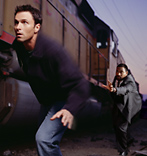
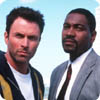

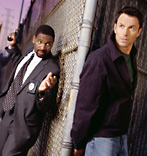




In addition to spawning a second TV series with the same name, premise and characters, The Fugitive over the years has inspired a wave of other shows which paid tribute to its unique essence in one way or another — from elegant tips of the hat to blatant rip-offs.
The most direct successor to the original series is the show CBS launched on Friday, October 6, 2000 at 8 p.m. — also called The Fugitive. It was produced by Arnold Kopelson, one-time producer of a big-screen Fugitive knock-off, and his wife Anne. Though their new Fugitive earned the approval of the critics and attracted a major fan base, it was canceled after only one season. In fact, after the plug was ignominiously pulled on their favorite show, which ended with a woefully unresolved cliff-hanger, some die-hard fans even started scripting their own episodes.
The Kopelsons' version was, in a way, The Fugitive: The Next Generation, since the updated Richard Kimble, Tim Daly, is the son of James Daly, the guest star who hunted Lieutenant Gerard with a rifle in an episode of the original show. Gerard in this version is played by Mykelti Williamson, of Forrest Gump fame; though his first name is Philip, as in the original (rather than Sam as it was the movie), his colleagues on the show prefer to call him ``Bubba'', and he becomes personally obsessed with Kimble's case only after hearing that the fugitive is supposed to have a really good recipe for shrimp gumbo that he would like to add to his collection.
The first episode of the show gives a good picture of the over-all formula, which is much closer to that of the original series than the movie ever was. The writers serve up a stew containing many warmed-over moments from such original episodes as FEAR IN A DESERT CITY, SEARCH IN A WINDY CITY, STROKE OF GENIUS and THE IRON MAIDEN. These are leavened with schmaltzy set pieces, such as the one at the end in which Kimble is seen giving his last crust of bread to a hungry stray dog. Such cloying bits, which would have fit right in with the more mawkish tone of the original's color season, seem as if they could well have been cannibalized from unused scripts for Touched By An Angel (a show that in its turn owes no small debt to the first Fugitive) that the writers found lying around in some CBS archive.
As the show's protagonist, Tim Daly evokes David Janssen very strongly, even adopting some of the same characteristic gestures and facial expressions to indicate how Kimble's basic good-natured optimism and faith in people must be tempered by his awareness of the grim situation in which he finds himself. Williamson makes Gerard likeable without turning him into a quaint character the way Tommy Lee Jones does in the movie. He is reserved and dignified but not at all sinister and fails to convey the sense of menace that Barry Morse always could achieve seemingly without trying. The new improved one-armed man, seen fleetingly in the premiere episode as well, has a prosthesis this time, but his features bear a strong resemblance to those of the original show's Bill Raisch. An additional recurring character joins the ensemble in later episodes: a sleazy ex-cop hired by the family of Kimble's wife to hunt Kimble down. But missing from the new version's dramatis personae is one of the main figures who helped to set the tone in the original series: the unseen narrator whose voice-overs were used to frame each episode. (Though not credited, the voice in the original belonged to William Conrad.) Executive producer John McNamara said he wanted initially to have a narrator in his new version of the show, but then came to realize that this device was an outdated ``holdover from radio''. According to an interview in Entertainment Weekly, McNamara hoped to follow in the footsteps of more recent hot-shot TV producers like David (Ally McBeal) Kelley and Joss (Buffy the Vampire Slayer) Whedon, and take their narrative innovations ``to the next level of storytelling''. In the first episode, this ``next level'' generally involves the rampant use of silly slow-motion close-ups at crucial points, apparently in a clumsy, heavy-handed attempt to heighten the tension. When the one-armed man comes on the screen, the sound of raspy over-dubbed breathing à la Darth Vader is added in as still another gimmick.
One of the real narrative innovations that makes the original Fugitive one of the most interesting of all television series is its use of an over-arching storyline involving characters who recur only intermittently. Many fans of the show have observed that Lieutenant Gerard appears in a surprisingly small fraction of the episodes, and the one-armed man appears even less often than Gerard. Members of Kimble's family also turn up from time to time as the background plot of the wronged man's efforts to exonerate himself slowly evolves. Most of the time though, attention is focused on individual stories involving one-shot characters who will not return after their dramas have been played out over a period of one or two hours. The skillful balancing of this disjoint episodic structure with the undercurrent of a continuing saga has rarely succeeded so well, though a number of other series have made the effort. An especially distinguished example of this kind of balance was achieved by Chris Carter's X Files in the 1990s. In that respect, Carter derives more from the original Fugitive tradition than McNamara and the Kopelsons. In their version of The Fugitive, Gerard and the one-armed man pop up all the time, even to the point where they become tedious, in the opinion of some viewers.
Computers
were not unknown to the writers of the original series, but the new
show used them more frequently in its storylines, including
some interesting plot twists involving the web. For instance,
Kimble goes on-line to track the one-armed man from
cybercafes across the country. And in an episode entitled
DrRichardKimble.com, the fugitive meets up with a ``computer
nerd'' who has built a
website devoted to him . . .as if anyone
would be geeky enough to do something like that in real life!
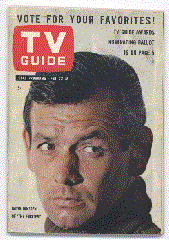
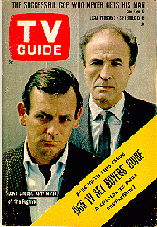
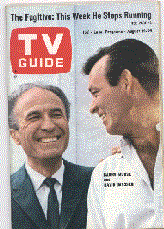
(sources: http://www.tsrcom.com/NeatStuff,
Jim's TV Collectables)
One of the first shows to capitalize on The Fugitive's
successful formula was The Immortal, the series starring
Christopher (Rat Patrol) George as a race-car driver with an
extraordinary blood type. The chemical structure of his blood not only
renders him virtually immune to the aging process, but it also allows
him to recover from serious injuries with miraculous speed, and makes
him resistant to all forms of disease and pestilence. Like Richard
Kimble, though, the Immortal is a hunted man; unscrupulous people want
to turn him into a one-man blood bank, since a transfusion from him is
seemingly tantamount to a quaff from the fountain of youth. The series
follows George on a lonely odyssey across the
country, and documents his encounters with various guest stars
along the way, many of whom he helps, with Kimble-like generosity —
he's always ready to lend a hand or a pint of blood if the need
arises. Because of his unusual powers of healing, though, the Immortal
is often giving himself away and has to always keep moving on to the
next town, in much the same way that Richard Kimble, for all his
bafflingly cunning efforts to camouflage his true
appearance, keeps getting recognized wherever he goes. The
Immortal premiered in 1970, but unfortunately did not live up to
its name, and was canned the year after.
Steve Elftmann
suggests that the show Run Buddy Run should also be counted as
a part of the Fugitive legacy. It was a comedy on CBS which,
according to Steve, premiered (and was cancelled) while The
Fugitive was still on the air. ``Jack Shelton was the star, and he
was running away from gangsters,'' Steve says. (An episode of Get
Smart apparently also took a more humorous look at the
relentless-pursuit theme at around the same time.) Steve also
mentions the show Run For Your Life as having at least as many
Fugitive similarities as The Immortal.
The 1970s TV show The
Incredible Hulk asked the tantalizing question: What would
The Fugitive have been like if Dr. Richard Kimble had gotten
belted by gamma rays, causing him to mutate into a giant green
body-builder from time to time? Bill Bixby of The Courtship of
Eddie's Father is chosen to play the Kimble figure, here called
Dr. David (Bruce) Banner. Like Kimble, he is haunted by the death
of the woman he loves, a fellow doctor who was trying to cure
him of the strange radiation sickness from which he is
suffering. In fact, this woman's death is falsely blamed on Dr.
Banner's alter-ego, the Hulk. As a result, Banner must hide in
lonely desperation from a reporter (Jack Colvin) who is relentlessly
pursuing the Hulk in order to expose his secrets to the world. Every
episode also includes an appearance by Lou Ferrigno as the Hulk, whose
bulging muscles erupt from mild-mannered Bill Bixby's shirt
and trousers at just the appropriate moment. Once he's turned
into the Hulk, some slow-motion heroics involving the vanquishing
of local wrong-thinkers is sure to follow. When all the
excitement is over, though, Bill Bixby always manages to
find other unripped shirts and trousers to put back on,
though it's never entirely clear where he stores this inexhaustible
wardrobe of his as he travels from town to town. In The
Fugitive, it was also somewhat of a mystery that Kimble never
seemed to run out of nice new suits to wear even after so many years
on the run. Kimble at least sometimes was seen to
do some laundry, a task however
seemingly beneath the dignity of such a superhero as the Hulk.
(The connections between The Fugitive and The Incredible
Hulk even extend to some of the behind-the-scenes crew on
the two shows, as Todd Pence
points out. Dan Ullman, author of the script for the Fugitive episode
SECOND SIGHT, also penned the
episode Blind Rage for
The Incredible Hulk — or maybe it'd be fairer to say he
cribbed the script for that episode from his earlier Fugitive
effort, since both stories exploit the same rather tired contrivance
of having the main character temporarily blinded in an accident.)
Valerie Rodell recalls
another '70s-era knock-off that seemed intent on taking the
Fugitive concept to more of a kiddie audience: Run, Joe,
Run, that Saturday-morning half-hour drama series about a German
shepherd that was falsely accused of attacking somebody. ``Every time
he saw his master, he ran again, not realizing that his master was
trying to bring him back to clear his name,'' Valerie says.
The 1978 TV-movie remake of Les Misérables seems to have
been informed at least partly by The Fugitive, which in turn
also drew some inspiration from the original Hugo
novel. In particular, the portrayal of Inspector Javert by Anthony
Perkins seems to have been strongly influenced by the character of
Lieutenant Gerard as created by Barry Morse. This movie was directed
by Glenn Jordan and written by John Gay, and also features Richard
Jordan as Richard Kimble — uh, Jean Valjean, that is.
R.D. Heldenfels, writing in the Akron Beacon Journal, sees a
connection between The Fugitive and
Hawaii Five-O.
In what he calls ``a blatant bow'' to the
lame conclusion of Kimble's chase, the last episode of
Hawaii Five-O shows McGarrett finally ending his relentless
pursuit of perennial bad guy Wo Fat. Like the one-armed man, Wo Fat
doesn't survive to stand trial, or even to get booked by Danno, for
that matter.
In the 1980s, the series Fugitive & Son (also known as
Starman)
picked up on the theme of a wandering hunted man, in this case Robert
Hays, a kindly otherworldly visitor pursued by an agent of the
government who wants to capture him so that they can learn all his
extra-terrestrial secrets in their lab. Unlike Richard Kimble, though, this
fugitive is accompanied by his teen-aged son, who is half alien, half
human, on a quest to find the kid's mother — not unlike Kimble's
quest to find the man who killed his wife. Along the way, they
sample many slices of life from the American pie, and
visit scenic locations throughout the
country. The protagonist of this show, like the Hulk and the Immortal
before him, is able to touch the lives of those he encounters, often
opening their eyes to the joys of life in that hokey, sentimental kind
of way so familiar to viewers of the color season of The Fugitive. (At her
interesting Starman
website, Clare O'Farrell compares
the "naive and optimistic" Robert Hays character to Candide, because
of the way that "the whole world is constantly new and surprising" to him.)
One episode of this series actually involves the Starman's pursuers
locating him after they see his by-line on a picture he took for a
small-town newspaper, though the town's name in this case is not
Northoak.
Another show that started in the '80s, Quantum
Leap, also exhibits some amazing
Fugitive ties, according to M. Wild.
More recently, in Twin
Peaks, David Lynch gave a nod to a certain ``runaway'' hit
'60s TV show by adding a one-armed man as one of his recurring
characters. In fact, Lynch — fully living up to his reputation as a
twisted brain — melded two Fugitive characters into one,
since this one-armed man is called Gerard and has a sort of split
personality — half good, half evil.
In 1996 yet another Fugitive follower hit the ground running —
Stephen J. Cannell's syndicated TV show Two. In this version of the
apparently perennial story, the Kimble clone, Gus McClain, has been
framed for the murder of his wife by his evil
twin Booth, who is in fact the real culprit. Both twins are played
by the same actor, Michael Easton, who in fact has real
ladykiller looks. Gus must relentlessly pursue
Booth, while himself being pursued relentlessly by FBI Agent Terry
Carter, a sort of Philip Gerard with an extra X chromosome.
(An analogous Fugitive gender-bender can apparently be seen
on the ABC drama Lost, according to TV
Guide; here though it's Kimble who has been turned into a female —
and an Aussie to boot — chased by law-enforcement agencies after being
victimized by a one-armed mate Down Under.) The hero of Two escapes from
the police en route to prison, à la The Fugitive,
thanks to a serendipitous accident. Somewhat less serendipitously, series
creator Cannell happened to work with a guy named Roy Huggins —
a.k.a. the creator of The Fugitive — on
The Rockford Files back in the '70s. Come to think of it,
another of Cannell's '90s brainchildren, the show Renegade,
covers some of the same by now very familiar ground. Here the victim
of a frame-up, hunky biker dude Lorenzo Lamas, is chased across the country
by a sleazy cop named ``Dirty Dutch'', who is portrayed by none other than
Stephen J. Cannell himself. Oddly, Lorenzo Lamas is since supposed to be
the star of another series called The Immortal, which may or may
not be a reincarnation of the previous Fugitive-inspired series of
the same name.
The 90s also gave TV audiences Nowhere
Man, a show which many fans have compared to The Fugitive for the unparalleled
sense of paranoia it evoked. Like Richard Kimble, the protagonist of Nowhere
Man is suddenly and arbitrarily, through no fault of his own, thrust
into a shadowy world where everyone is out to get him. Like Kimble, he
is forced to leave his wife and comfortable life behind and set out on a hunt
to unearth the truth that will restore his life to normalcy, while at the same
being hunted down himself . . .
Many other shows besides these are indebted to The Fugitive in
ways large or small. Shows that have been identified as having
elements derived from The Fugitive include Kung Fu,
Branded, The Adventures of Brisco County Jr., The Invaders,
The Pretender, The Phoenix, The Visitor,
and Hot Pursuit (nicknamed Mr. and Mrs. Fugitive
by the late great Dave Brown). But undoubtedly the most
insightful echo of The Fugitive in the years since
it went off the air was The Fugitive Guy,
Chris
Elliott's exciting excursion into the world of suspense drama,
which aired as a series of segments on Late Night with David
Letterman in 1985. Though he publicly contended that he had never
heard of the original series (``Are you thinking of Mannix?''
he replied quizzically when asked whether he had been influenced by the
show), Elliott's skillful manipulation and augmentation of its characteristic
themes betray his masterful familiarity with it as the source of his
inspiration. In such classic Fugitive Guy episodes as Eenie Meenie
Minie Murder (September 17, 1985) and A Pinch of Salt, A Dash of
Death (October 17, 1985), Elliott's title character, Roger Campbell,
toils at many jobs — including camera operator
and make-up man — on the David Letterman set. His macabre
duel with ``the one-legged man'' kept Late Night viewers on the
edges of their seats for over four months. The roller-coaster ride
finally came to an end on November 21, after NBC officially cancelled
The Fugitive Guy. But the final episode,
Murder-Go-Round, which wrapped up all loose ends in a
conclusion a hundred times cleverer than
the one written for
the original show, will live on in the collective TV-watchers'
unconscious as a milestone of the post-Fugitive era.
(Thanks to donz5@aol.com,
jd130@aol.com and
Todd Pence for
information about The Fugitive Guy.)
 Back to HOMEPAGE OF THE HUNTED <http://unchance.net/Fugitive>
Back to HOMEPAGE OF THE HUNTED <http://unchance.net/Fugitive>